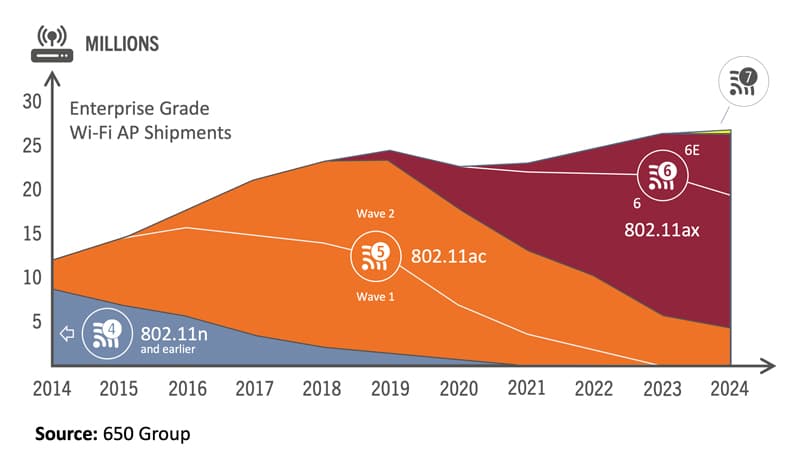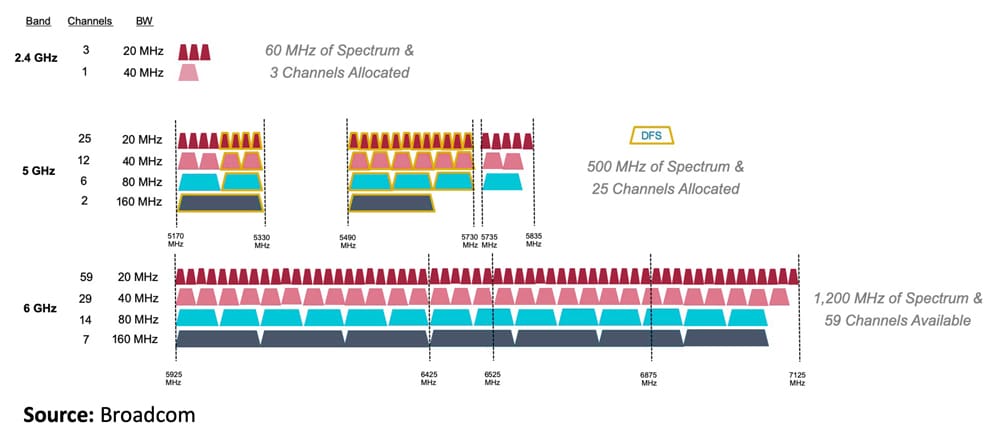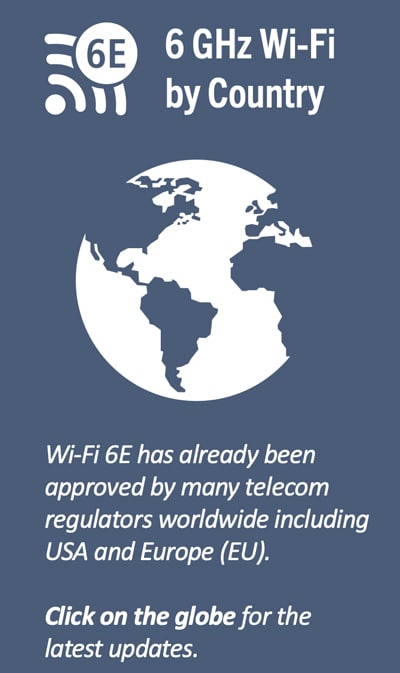White Paper Excerpt
Wi-Fi 6E – Tripling the available spectrum
Wi-Fi in the 5G era – White Paper
This is an excerpt from our white paper Wi-Fi in the 5G Era – Strategy Guide for Operators. The full white paper is available here if you like what you read. Don’t hesitate to contact us if you have any questions.

Wi-Fi in the 6 Ghz Band
Wi-Fi 6E, Wi-Fi 6 on pristine 6 GHz spectrum, will boost Wi-Fi speeds by at least a factor of four and capacities by even more with latencies as low as 2 milliseconds. This constitutes a paradigm shift in connectivity.
Wi-Fi 6 is in itself a big quality and data rate improvement over existing Wi-Fi services, most of which currently are still based on the Wi-Fi 5 (802.11ac, 5 GHz services) or even Wi-Fi 4 (802.11n, 2.4 GHz) legacy standards. Now add to this Wi-Fi 6E, an opportunity for the new standard to operate in the pristine 6 GHz band. The connectivity experience will improve by an order of magnitude in speed and quality.
It is also well documented that the rate of market penetration and rollout of both devices and access points supporting the Wi-Fi 6 standard has thus far well exceeded the pace of all previous standards. Within a couple of years, industry analysts expect the vast majority of enterprise-grade Wi-Fi access points to be Wi-Fi 6 capable.

The rate of Wi-Fi 6 market penetration will be very fast, as evidenced by the curve above.
By 2023 analysts expect the vast majority of enterprise-grade access points to be Wi-Fi 6-capable.
Wi-Fi 6E Triples the Available Band for Wi-Fi
The 6 GHz Wi-Fi story is recent – and the date April 23, 2020, will be forever etched into the annals of wireless and technology history. On this date, the commissioners of US telecom regulator FCC (Federal Communications Commission) voted unanimously five to zero in favor of releasing 1.2 GHz of pristine 6 GHz spectrum to Wi-Fi.

Chart depicting Wi-Fi channels within the 6 GHz band for the US (bottom) and the EU (top).
In the future Wi-Fi 7 standard (802.11be) 320 MHz channels will be defined.
Since then, several other countries have followed suit. It is largely expected that most countries in the world will release some parts of the 6 GHz band as unlicensed spectrum in the course of the next few years. In the US the full 6 GHz band (including a section of band extending into 7 GHz) can already be used for indoor Wi-Fi services (for so-called Low Power Indoor or LPI services).

Chart depicting Wi-Fi channels for the US in 2.4 GHz, 5 GHz, and the new 6 GHz band.
The new 6 GHz band more than triples the total available band for Wi-Fi in the USA and makes room for a total of seven new 160 MHz channels in 6 GHz.
The huge new band allocation more than triples available Wi-Fi band in the US and will close to double available bands within the EU. In the US a total of seven 160 MHz-wide Wi-Fi channels will be available, while in Europe that number will be three (see the channel allocation table below). This means that Wi-Fi devices – including smartphones, tablets, laptops, etc. – will soon be operating at multiple gigabits per second of speed over Wi-Fi.
Free from Interference from Legacy Wi-Fi
One important aspect of Wi-Fi 6 in the 6 GHz band – dubbed Wi-Fi 6E by the Wi-Fi Alliance – is that only Wi-Fi 6E is certified to operate in the said spectrum and hence no legacy Wi-Fi systems will be around to generate interference within the new band. The quality of 6 GHz Wi-Fi services will therefore likely be close to that of cellular – except several multiples faster than most current wide-area coverage 5G data rates, with the exception of localized and outdoor mmWave-based 5G.
The interference-free 160 MHz channels in Wi-Fi 6E means that smartphones and other mobile devices will be able to operate at peak theoretical speeds of more than 2 Gbps or – says chipset maker Broadcom – up to 1.4 Gbps at a distance of 7 meters non-line-of-sight from a Wi-Fi 6E access point.
In new enterprise deployments the adage ‘eighty is the new twenty’ will apply for Wi-Fi 6E: Standard 6 GHz Wi-Fi deployments will use 80 MHz channels instead of the usual 20 MHz channels applied today. This is because permitted power levels (in the US) are defined in such a way that there is no penalty for using wider channels and hence no real reason not to use them. As a result, average enterprise Wi-Fi data rates will be at least quadrupled.
Wi-Fi 6E technology will in addition deliver latencies as low as 2 milliseconds, which – as a starting point – will enable much more responsive and ‘immersive’ connectivity experiences, initially for gaming, fast video conferencing, AR/VR, and more and eventually for innovative new wireless enterprise applications.
In summary: Based on 480 MHz to 1200 MHz of new unlicensed (free) spectrum, Wi-Fi 6E will, depending on country-specific regulations, deliver multi-gigabit Wi-Fi speeds and capacities that by a wide margin will outperform current cellular systems indoors. And now – for the first time in Wi-Fi history – the application of Wi-Fi 6 and 6E technology using OFDMA, means the quality of Wi-Fi services will be similar to that of cellular.




